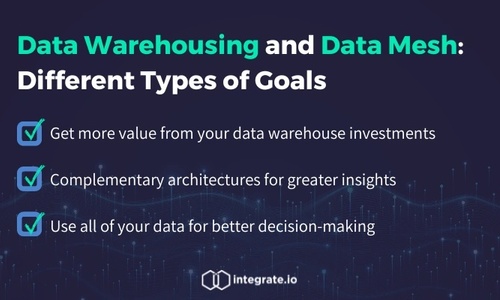Welcome to an exclusive guest post by prominent American computer scientist Bill Inmon. Bill Inmon is a prolific author, recognized by most data managers and scientists as the father of data warehousing. Inmon wrote the first book exploring the central concepts of data warehouses and has written over 60 more books since. Inmon brought data scientists together for the first data warehousing conference, and now offers a range of educational classes in data management, plus he also writes for a number of prominent publications.
Our 5 key takeaways:
- Goals are either binary or variable
- Data warehousing falls into the “variable goal” category
- Not all data needs to go into a data warehouse
- Data mesh and data warehouse concepts complement each other
- Integrate.io is the integration solution for bringing the data you need into your data warehouse
The world is full of different types of goals. Consider football. The goal in football is at the end of the field. A runner either crosses the goal or they don't, when trying to make a touchdown. Or, consider basketball. In basketball, when a player shoots the ball, the player’s shot either goes through the net or it doesn’t. Alternatively, consider ice hockey. When a hockey player shoots the puck, it either goes into the net — or it doesn’t.
These kinds of goals can be called fixed, finite goals. These goals don’t move, and they either are accomplished or they are not. It is a binary choice–yes or no.
Table of Contents
Data Warehousing: A Variable Goal
Data Mesh Thinking Complements Data Warehouse Architecture
Beyond Binary
But there are other kinds of goals that are not fixed and finite. Consider personal health. You try to attain and maintain your own personal health all your life. Normally, you don’t just give up on improving or maintaining your health. And, there is no such thing as finally attaining your health. However healthy you are, you want to continue to try to improve your health. Once you attain good health, it is a constant challenge to maintain your health. Personal health is a goal that is constantly moving and is never completely achieved.
You could also consider weightlifting. Whatever weight you lift, there is always a heavier weight to be lifted. There is no end to the weights to be lifted. Personal health and weightlifting are but two examples of constantly changing goals — a constantly moving, variable goal.
In this vein, let’s examine data warehousing. Is a data warehouse a finite goal or a variable goal? Unquestionably data warehouse is a variable goal, not a finite goal.
Integrate.io provides a highly secure and flexible data transformation platform, utilizing super-fast CDC capabilities, ETL and reverse ETL to bring all the data you need into your data warehouse. Read more about data warehousing and data integration on our blog.
Data Warehousing: A Variable Goal
There are several reasons for the variability in achieving a data warehouse. The first reason is that not all data needs to go into a data warehouse. There are whole classes of data that do not belong in a data warehouse.
A second, more important reason why the data warehouse is a variable goal is because of the fact that new data is constantly appearing in the organization. As long as the corporation is moving forward, new products are being created. New competition is being encountered. New packaging of products occurs. In a word, the corporation that is alive and prosperous is constantly changing and is not standing still. And as the corporation changes, new data is created. And that data needs to be integrated into the data warehouse. So, as long as the corporation is growing and changing and thriving, there will always be a new crop of data that needs to be placed in the data warehouse. For this reason, the data warehouse is never complete.
The data warehouse is not a fixed, finite goal. The data warehouse is a variable goal.
Now, does the fact that the data warehouse is not complete–ever–or not perfect–ever–give pause for concern? Not at all.
Data Mesh Thinking Complements Data Warehouse Architecture
Just because there is some data that is not in the data warehouse does not mean that the organization cannot use the data that already is in the data warehouse. The data that resides in the data warehouse and that has been integrated can be used analytically. In fact, the data warehouse should contain at least 90% or more of the data that belongs there. But the fact that the data warehouse does not contain 100% of the data used by a business is a function of a growing, dynamic organization.
One argument that the data mesh/data mash line of thinking proclaims is that a data warehouse is never complete. The data mesh/data mash people are very correct in saying that. But at the same time, it was never true that the data warehouse was ever complete. But that is no argument for not having a data warehouse.
Data mesh/data mash and data warehouse should be complementary architectures. But the data mesh/data mash people don’t see it that way.
They ought to.
Make the most of your data warehouse with the new ETL platform with reverse ETL and CDC capabilities from Integrate.io. Try it for yourself — sign up for a 14-day trial and book a consultation with us so we can better understand your data integration needs.
Bill Inmon, the father of the data warehouse, has authored 65 books and was named by Computerworld as one of the ten most influential people in the history of computing. Bill’s company, Forest Rim Technology, is a Castle Rock, Colorado company. Bill Inmon and Forest Rim Technology provide a service to companies in helping those companies hear the voice of their customer. See more at www.forestrimtech.com.










